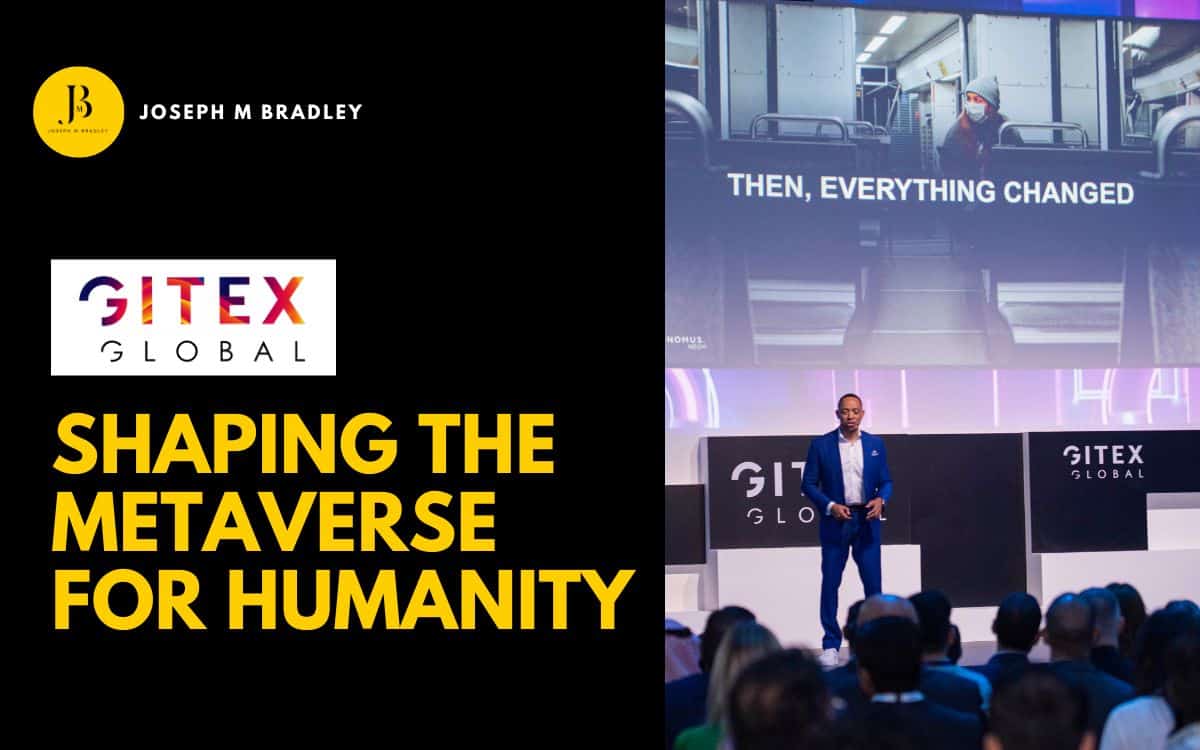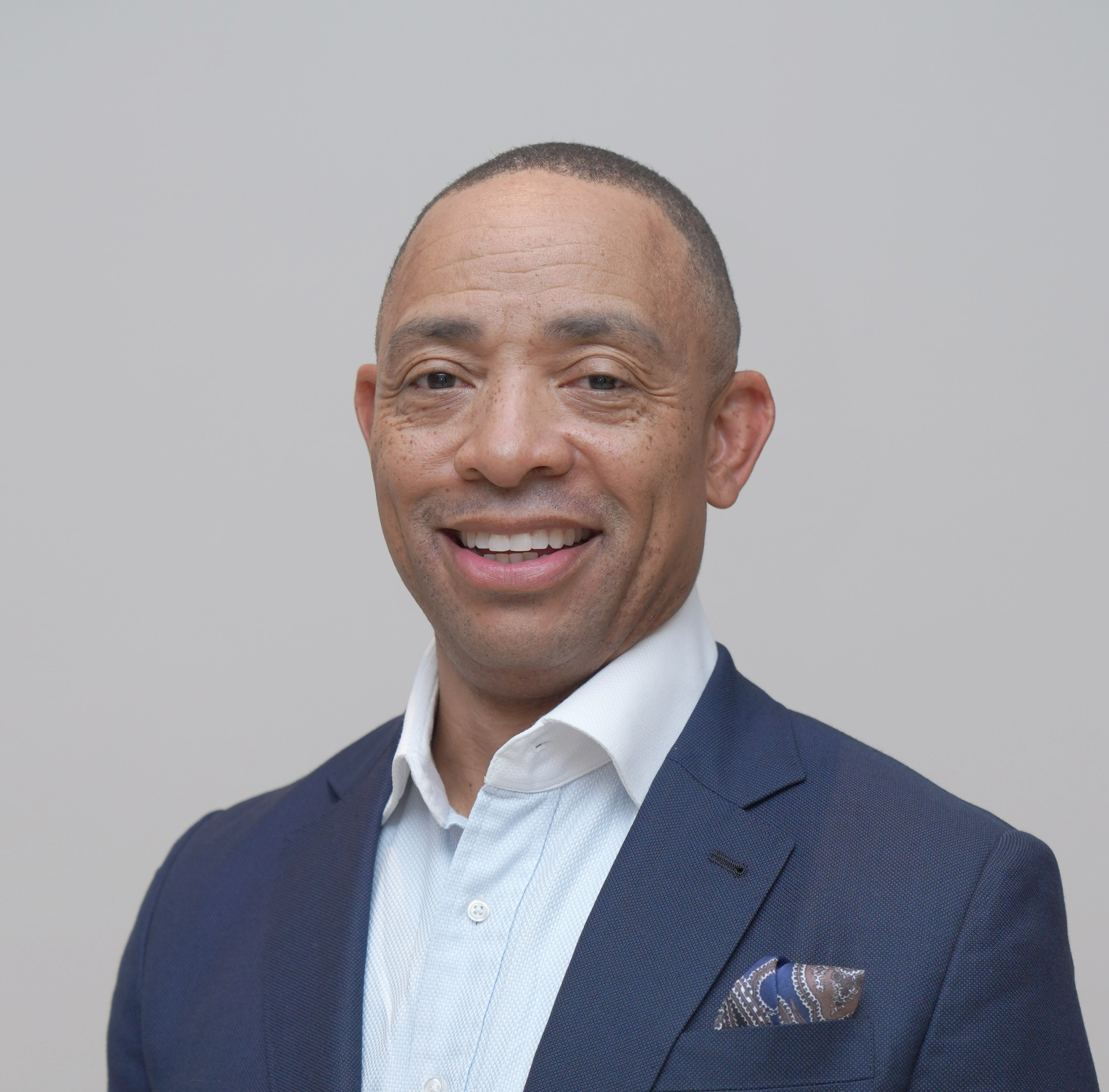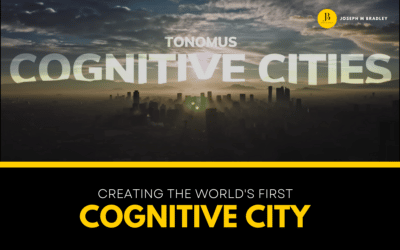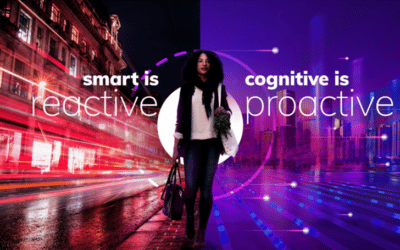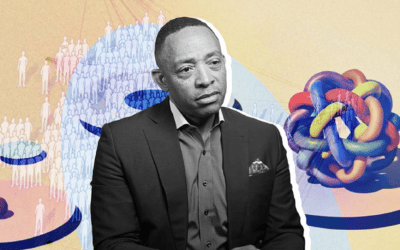In his GITEX Global keynote, Joseph Bradley discusses his vision for the metaverse and how it represents our ability to keep moving, to connect, to live, to love, to be human, and create value.
Transcript
How are you today? I’m super excited to talk to you about a very passionate topic that I have. When you think about the word, “metaverse”, what comes to your mind? Games. Gaming. My nephew Malcolm is about six years old, and he says, Uncle Jojo, give me some Roblox. That’s his definition of the metaverse. But I’m here to tell you, we at TONOMUS think it’s so much more than that.
If you can recall what happened on January 29th, 2020, the world was calm. Everything was great. We were super excited about the future. We had just finished with New Year’s Eve, and everyone was talking about all the great things they were going to do and accomplish. And then everything changed.
You had schools with no children.
You had airports with no passengers.
You had tourist destinations, but no tourism.
But we said that’s okay. We got you. We’re tech. We go to all these conferences. Don’t worry. When the world stops moving, we’re digital. All these buzzwords we talked about: next generation, collaboration, agility, and what do we do? When the world couldn’t move, we in the tech community said we’ll replace a “Hello”, with “You’re on mute. No, no, you’re on mute. No, no, no, no. You’re on mute.” Right. That’s what we gave to the world.
When you think about the cost, what’s at stake for us, whether it’s the $4 trillion that was caused by COVID or where there was six months to two years of education lost by children, or the 39% increase in mental health issues…
It is so much more, the Metaverse. It’s not a game to us. The Metaverse represents our ability to keep moving, to connect, to live, to love, to be human. That’s what it represents for TONOMUS. And if you think about the examples that exist in the world today: eternal Notre Dame, the beautiful church, beautiful building. And then what happened? There was a fire. And they struggle with still bringing this experience. Don’t worry. They created a metaverse-like experience, allowing people to engage and be able to participate in that church while it was reconstructing. The virtual experience actually paid for 30% of it.
Travis Scott in the middle of COVID at its peak said, “Hey, I want to do a concert.” 250,000 people is the maximum capacity for a stadium. But what happened? He took that concept in connecting, went on to Fortnite, and all of a sudden, he was able to connect with 27 million people in that event.
And if you bring something even closer to home and closer to a heart, many of you heard of The Line, the futuristic city, 170 kilometers long, 500 meters tall, 200 meters wide, the same throughput for 9 million residents, and a footprint of 2% the size of a normal city. Well, how are we using the metaverse in that sense? We made a commitment. We said 5 minutes – in 5 minutes you’ll be able to get to whatever core location you need to. How do we know it’s 5 minutes? Because we walked it. We’ve done it. Well, sort of.
We’ve used metaverse-based technologies to model it and to ensure that our commitments are kept. And when you think beyond that, you think about NEOM being the first “multiverse city”, merging physical and digital, allowing you to engage not just one to one, but one to many.
You think about the complementary experiences with gamified education. How many of you like to work out? Okay. You probably heard about this great new workout. It’s called MAS. Have you heard of MAS? Any of you heard of the great new workout? It’s called Malcolm at School. Malcolm is my six-year-old nephew.
And what a workout. Because my sister tricked me. She said, “Guess what? You just got to watch him for a little bit.” But she didn’t tell me that taking him to “school” was actually in my living room, and it was him sitting down watching this teacher on a video screen trying to keep a six-year-old kid occupied. Now that is work. But then as soon as it was over, I said, “How about playing a video game?” That six-year-old kid transformed into a zombie. He was stone-faced looking. Imagine being able to create that same experience from an education perspective, right? The ability to create every school experience ultimately turns into a field trip.
You think about the digital experience associated with talent. $64 billion we lose every year because we simply cannot find the right person at the right time to give us the information that we need. In a metaverse application, we can address those situations and address those problems.
My favorite, the ability for us to ultimately create a mixed-reality immersive experience. When you hear about NEOM, if you’re sitting in New York, are you going to get on a plane and just blindly travel 20 hours to go check out this new city? No, and we understand that. You’re going to go on and say, hey, I heard about this new city, but let me check it out on this multiverse platform. Oh, this is great. Let me go and buy a digital apartment, and I can engage and create content. I’m having a great time. And then as more people start buying these digital apartments, we send a note that says, “Hey, check this out. We’re going to build your apartment for real. Are you interested?” You go, “Oh this is great. But I don’t like humidity. And this guy, Joseph, said it wasn’t humid, but I don’t know if he’s really telling me the truth. Before I spend all of his money for this apartment, I might want to teleport in. So let me upgrade my subscription. So now I’m sitting at my desk, I can appear as a hologram, and I have the ability to engage with those in NEOM and say, “Hey, is it truly dry as he said, it is?” If he says, “Yes,” then great, I’m all in and be able to purchase that type of apartment or that type of building.
I want to talk to you about some golden rules if you want to execute a metaverse. I want you to realize, rule number one: inclusion is the currency of the metaverse. It is a people platform. That means, by definition, the more people that participate, the greater the value of the platform. It’s not about 7 million people. It’s about 7 billion that you want to touch. If you want to touch those 7 billion, you’ve got to go beyond the digital divide. You’ve got to have connectivity prevalent. You’ve got to go beyond physical ability. What is the metaverse like if you can’t see? What is the metaverse like if you can’t hear? What’s the metaverse like if you have a disability? It must be fully inclusive, and you have to go beyond borders. It’s not about the people that just live in the city. It’s about the people the city can impact. So, diversity is one thing – only the potential to create value. You can have a diverse room, but if this room is not engaging, inclusion is the realization of value by driving full participation.
Second Golden Rule: Now, on this one, I’m gonna need some help. Where are my Millennials in the audience? Come on, Millennials, where are you at? Okay, very cool. And Generation Z’s in the audience? Okay, very cool. And people that want to be a Millennial, raise your hand. Very good. Very good. This next one I need your help on. I’ll need your help on this one. The physical is an add-on to the digital. Uh oh…The physical is an add-on to the digital. It’s not the other way around. If you’re trying to drive an inclusive environment, by definition, you want to include the maximum number of people. The physical world has limitations. You can only have so many people in a city, but if you want to touch 7 billion, you’ve got to understand the physical and augment the digital.
Now you know this to be true inherently. You know, when you go to an e-commerce platform, some of the most valued companies in the world didn’t start by building a building. What did they do? They started digitally and then they went in and augmented and started building stores to complement the digital.
If you look at that Fortune 500 balance sheets 40 years ago, they were dominated by physical assets. Now 90% of those balance sheets are digital assets. I know this is tough but I’m not saying the physical world doesn’t matter. That’s not at all what I’m saying. I’m telling you, though, that if you believe the metaverse is inclusive and is for everyone, the physical world, by definition, is limited. So you have it, but it augments the digital. That is a core concept that if you want to execute, you have to be able to grasp that.
Now, the movement between the two creates huge opportunities. As I move from the physical world to the digital world, that’s where the monetization occurs. That’s where value creation occurs in myriad ways, whether it’s branding, virtual content, NFTs, you’ve heard the various stories. It’s this movement that creates value. Gucci, I love this concept. If you don’t know about Gucci, go to their income statement, and you’ll see a name on there, Laurie Bradley. That’s my wife. She’s actually on the Gucci statement when she goes and loves to buy. Right. So Gucci sold. What do they do? They got this great purse line, but they made a digital version of the physical purse. They made a digital version of the physical purse. Some of you ladies like ooh! Ahhh! Yes, you can hide that one, too. You can buy as many those you need of those digital versions. Right. You don’t have to have space in your house. You don’t have to figure out how to pack them in. Right? Not with the digital versions they pay, what, 20% more for the digital version than they paid for the physical version. I don’t know why, but they did. Right. These are opportunities to create value.
So when you think about how you execute, we’ll leave you with this:
Number one – one experience at a time. Don’t try to eat this whole elephant at once, don’t try to create this massive world and try to get all the experience in. Focus on improving an education experience. If you’re an enterprise, focus on improving onboarding, focus on improving collaboration, focus on a core element of the experience.
Second – metaverse. It’s not a purely digital world that doesn’t count. It’s not purely a physical city, that doesn’t count. It’s the duality of the experience. It’s the ability to blend both worlds together that creates the value.
And finally, probably the hardest thing people are saying. Applying a metaverse to something…what does that mean? That means that platform economics rule the metaverse. That means by definition, if you apply a metaverse to a city, it becomes a “metacity”. That means it follows platform economics. The more people you engage, the more inclusive, the more value the platform becomes. It’s just that simple. Just that simple.
Now I get that there is a fine line between radical innovation and wishful thinking. And you’re right, we’re pushing it. We want you to be bold. We want you to be courageous. We want you to join the movement.
Thank you very much.

